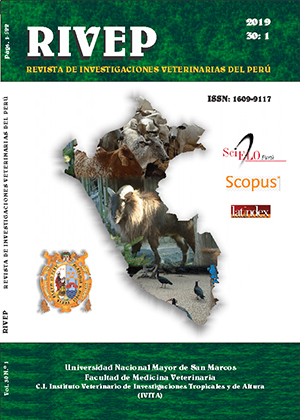In situ nutritional assessment of diets with passion fruit meal (Passiflora edulis) as replacement of maize (Zea mays)
DOI:
https://doi.org/10.15381/rivep.v30i1.14438Keywords:
ruminal degradability; agro-industrial waste; ruminant feeding; ruminal kineticAbstract
The parameters of in situ ruminal degradation of passion fruit meal (Passiflora edulis) included in diets for ruminants as replacement of maize were studied. A randomized complete block design was applied with four treatments (0, 10, 20 and 30% [T, T2, T3 and T4, respectively] of inclusion of passion fruit meal), three blocks (rumen-fistulated bovine) and seven incubation times (0, 3, 6, 12, 24, 48 and 72 hours). The differences between means were established using the Tukey test (p<0.05). T1 and T2 showed the highest (p<0.05) degradability of dry matter and organic matter at 48 and 72 h of incubation, respectively, while neutral detergent fibre and acid detergent fibre had a greater degradability in T4 and T3 at 48 and 72 h of incubation. The ruminal kinetics parameters were not significant in any of the variables evaluated. The results show that passion fruit meal can be used to replace maize up to 10% in diets for ruminants in the Ecuadorian littoral.
Downloads
Downloads
Published
Issue
Section
License
Copyright (c) 2019 Emma Torres Navarrete, Adolfo Rodolfo Sánchez Laíño, Ítalo Espinoza Guerra, León Montenegro Vivas, Cecilio Barba Capote, Antón García Martínez

This work is licensed under a Creative Commons Attribution-NonCommercial-ShareAlike 4.0 International License.
AUTHORS RETAIN THEIR RIGHTS:
a. Authors retain their trade mark rights and patent, and also on any process or procedure described in the article.
b. Authors retain their right to share, copy, distribute, perform and publicly communicate their article (eg, to place their article in an institutional repository or publish it in a book), with an acknowledgment of its initial publication in the Revista de Investigaciones Veterinarias del Perú (RIVEP).
c. Authors retain theirs right to make a subsequent publication of their work, to use the article or any part thereof (eg a compilation of his papers, lecture notes, thesis, or a book), always indicating the source of publication (the originator of the work, journal, volume, number and date).



